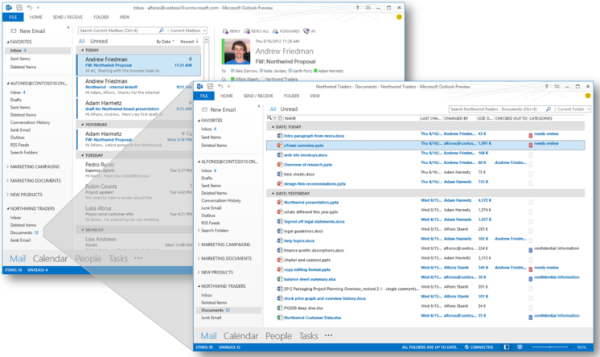One of my biggest pet peeves with Microsoft Outlook and SharePoint is the utter lack of integration between the two. Using native Microsoft tools, it is nearly impossible to save an email into a client/matter site, or view SharePoint content from within Outlook. It has always required third-party client add-ons; add-ons which aren’t free and increase system complexity.
But now there might be a way to achieve this natively. There is a new feature introduced with Exchange 2013 that, when combined with Outlook 2013 and SharePoint 2013, provides a single matter-centric view of both emails and documents within Outlook itself. It’s called Site Mailboxes, and you can find out the details on Microsoft’s TechNet Blog.
The current preview state of Site Mailboxes includes 4 areas for each matter: Inbox, Deleted Items, Documents, and Junk Email. All email content lives behind the scenes in Exchange 2013. All document content lives behind the scenes in SharePoint 2013. Matter teams are defined, and team members will see the Site Mailbox in their Outlook tree. They can also use the SharePoint portal to view the Site Mailbox and its email content on the web as well. Once a case is closed, the user could right-click and close the Site Mailbox in Outlook just as one would with a PST. See below for a preview of the interface, provided by Microsoft:
Here a few other advantages and features of Site Mailboxes:
- Content can be subject to legal holds via SharePoint
- Attorneys can send an email and CC the address of the Site Mailbox to send and file content
- Can be provisioned and assigned to users through automated SharePoint administrative processes
- Compatible with Office365
But hold on, before we get too giddy, it should be noted that this is NOT intended to act as a fully functional Document Management System. There are still some integration shortcomings (for legal users) between Word 2013 and SharePoint. In addition, this would be very cumbersome and difficult to use for environments with thousands of matters.
So what could be the use cases? I could see this working for very small or botique firms that do not have large case loads, or for war rooms or deal rooms. It will be interesting to see if Microsoft enhances the managability or adds more features to this as we get closer to the 2013 releases, and beyond. Perhaps this may lead to the combination of a native Microsoft platform including Office, SharePoint and Exchange finally meeting its potential as a viable ECM solution for legal.
